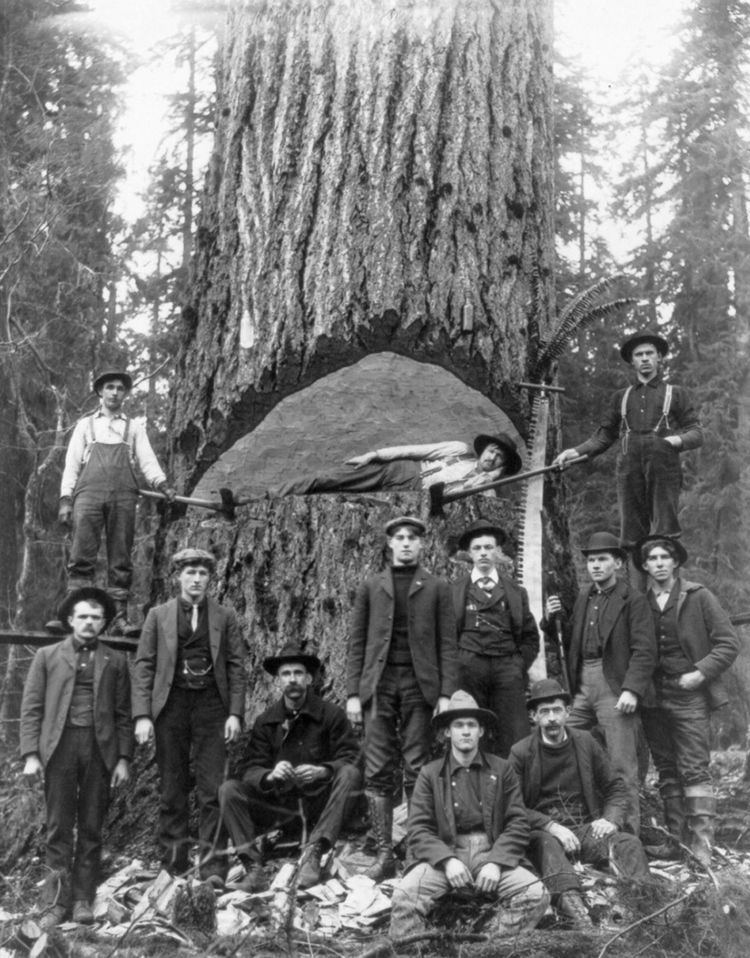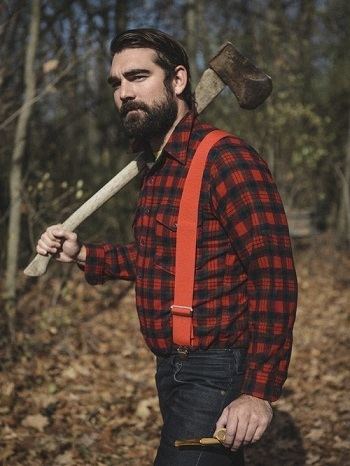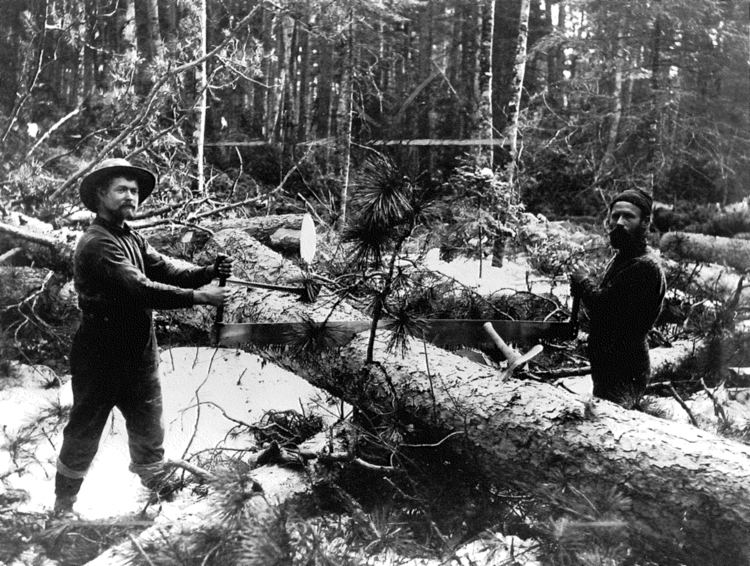 | ||
The risky life of lumberjack world documentary films hd
Lumberjacks are workers in the logging industry who perform the initial harvesting and transport of trees for ultimate processing into forest products. The term usually refers to a bygone era (before 1945 in the United States) when hand tools were used in harvesting trees. Because of its historical ties, the term lumberjack has become ingrained in popular culture through folklore, mass media and spectator sports. The actual work was difficult, dangerous, intermittent, low-paying, and primitive in living conditions. However, the men built a traditional culture that celebrated strength, masculinity, confrontation with danger, and resistance to modernization.
Contents
- The risky life of lumberjack world documentary films hd
- Names
- History
- The tie hack
- Lumberjack culture
- Modern logger
- Loggersports
- Popular culture
- Folklore
- Festivals and holidays
- Food and eateries
- Films
- Literature and film adaptations
- Music
- Periodicals
- Television
- Lumbersexual fashion
- Mascots and teams
- Competitions and events
- Train
- References

Names

The term lumberjack is of Canadian derivation. The first attested use of the word comes from an 1831 letter to the Cobourg Star and General Advertiser in the following passage: "my misfortunes have been brought upon me chiefly by an incorrigible, though perhaps useful, race of mortals called LUMBERJACKS, whom, however, I would name the Cossack's of Upper Canada, who, having been reared among the oaks and pines of the wild forest, have never been subjected to the salutary restraint of laws." The term lumberjack is primarily historical; logger is used by workers in the 21st century. When lumberjack is used, it usually refers to a logger from an earlier time before the advent of chainsaws, feller-bunchers and other modern logging equipment. Other terms for the occupation include woodcutter, shanty boy and the colloquial term woodhick (Pennsylvania, US). A logger employed in driving logs down a river was known locally in northern North America as a river pig, catty-man, river hog, or river rat. The term lumberjill has been known for a woman who does this work; for example, in Britain during World War II. In Australia, the occupation is referred to as timber cutter or cool cutters.
History

Lumberjacks worked in lumber camps and often lived a migratory life, following timber harvesting jobs as they opened. Being a lumberjack was seasonal work. Lumberjacks were exclusively men. They usually lived in bunkhouses or tents. Common equipment included the axe and cross-cut saw. Lumberjacks could be found wherever there were vast forests to be harvested and a demand for wood, most likely in Scandinavia, Canada, and parts of the United States. In the U.S., many lumberjacks were of Scandinavian ancestry, continuing the family tradition. American lumberjacks were first centred in north-eastern states such as Maine. They then followed the general westward migration on the continent to the Upper Midwest, and finally the Pacific Northwest. Stewart Holbrook documented the emergence and westward migration of the classic American lumberjack in his first book, Holy Old Mackinaw: A Natural History of the American Lumberjack. He often wrote colourfully about lumberjacks in his subsequent books, romanticizing them as hard-drinking, hard-working men. Logging camps were slowly phased out between World War II and the early 1960s as crews could by then be transported to remote logging sites in motor vehicles.

The division of labour in lumber camps led to several specialized jobs on logging crews, such as whistle punk, chaser, and high climber. The whistle punk's job was to sound a whistle (usually at the Steam donkey) as a signal to the yarder operator controlling the movement of logs. He also had to act as a safety lookout. A good whistle punk had to be alert and think fast as the safety of the others depended on him. The high climber (also known as a tree topper) used iron climbing hooks and rope to ascend a tall tree in the landing area of the logging site, where he would chop off limbs as he climbed, chop off the top of the tree, and finally attach pulleys and rigging to the tree so it could be used as a spar so logs could be skidded into the landing. High climbers and whistle punks were both phased out in the 1960s to early 1970's when portable steel towers replaced spar trees and radio equipment replaced steam whistles for communication. The choker setters attached steel cables (or chokers) to downed logs so they could be dragged into the landing by the yarder. The chasers removed the chokers once the logs were at the landing. Choker setters and chasers were often entry-level positions on logging crews, with more experienced loggers seeking to move up to more skill-intensive positions such as yarder operator and high climber, or supervisory positions such as hook tender. Despite the common perception that all loggers cut trees, the actual felling and bucking of trees were also specialized job positions done by fallers and buckers. Faller and bucker were once two separate job titles but are now combined.

Before the era of modern diesel or gasoline powered equipment, the existing machinery was steam powered. Animal- or steam-powered skidders could be used to haul harvested logs to nearby rail roads for shipment to sawmills. Horse driven logging wheels was a means used for moving logs out of the woods. Another way for transporting logs to sawmills was to float them down a body of water or a specially-constructed log flume. Log rolling, the art of staying on top of a floating log while "rolling" the log by walking, was another skill much in demand among lumberjacks. Spiked boots known as "caulks" or "corks" were used for log rolling and often worn by lumberjacks as their regular footwear.
The term "skid row", which today means a poor city neighbourhood frequented by homeless people, originated in a way in which harvested logs were once transported. Logs could be "skidded" down hills or along a corduroy road, and one such street in Seattle was named Skid Road. This street later became frequented by people down on their luck, and both the name and its meaning morphed into the modern term.
The tie hack
A specialty form of logging involving the felling of trees for the production of railroad ties was known as tie hacking. These lumberjacks, called tie hacks, used saws to fell trees and cut to length, and a broadaxe to flatten two or all four sides of the log to create railroad ties. Later, portable saw mills were used to cut and shape ties. Tie hacking was an important form of logging in Wyoming and northern Colorado and the remains of tie hacking camps can be found on National Forest land. The remains of flumes can be seen near Dubois, Wyoming and Old Roach, Colorado. In addition, a decaying splash dam exists near the Old Roach site as well. There tie hacks attempted to float logs down to the Laramie River for the annual spring tie drives, and the splash dam was used to collect winter snowmelt to increase the water flow for the tie drive.
Lumberjack culture
Tomczik (2008) has investigated the lifestyle of lumberjacks in 1840-1940, using records from mostly Maine and Minnesota logging camps. In a period of industrial development and modernization in urban areas, logging remained a traditional business in which the workers exhibited pride in their craft, their physical strength and masculinity, and guarded their individualism. Their camps were a bastion of the traditional workplace as they defied modern rationalized management, and built a culture around masculinity. At the peak in 1906 there were 500,000 lumberjacks; they took special pride in their work. Logging camps were located in isolated areas that provided room and board as well as a workplace. With few females present other than the wives of cooks and foremen, lumberjacks lived an independent life style that emphasized manly virtues in doing dangerous tasks. Men earned praise for their skills in doing their work, for being competitive, and for being aggressive. When not at work, they played rough games, told tall tales, and won reputations for consuming large amounts of food. By 1940, the business was undergoing major changes, as access roads and automobiles ended residential logging camps, chain saws replaced crosscut saws, and managers installed modern industrial methods.
Modern logger
Modern technology changed the job of the modern logger considerably. Although the basic task of harvesting trees is still the same, the machinery and tasks are no longer the same. Many of the old job specialities on logging crews are now obsolete.
Chainsaws, harvesters, and feller bunchers are now used to cut or fell trees. The tree is turned into logs by removing the limbs (delimbing) and cutting it into logs of optimal length (bucking). The felled tree or logs are moved from the stump to the landing. Ground vehicles such as a skidder or forwarder can pull, carry, or shovel the logs. Cable systems "cars" can pull logs to the landing. Logs can also be flown to the landing by helicopter. Logs are commonly transported to the sawmill using trucks. Harvesting methods may include clear cutting or selective cutting. Concerns over the environmental impact have led to controversy about modern logging practices. In certain areas of forest loggers re-plant their crop for future generations.
A recent Wall Street Journal survey on the best jobs in the United States ended by listing being a logger as the "worst" 3D's job, citing "work instability, poor income and pure danger". A Bureau of Labor Statistics survey of America's most dangerous jobs put loggers at the top of the list for 2004.
Loggersports
The sport of Loggersports grew out of competitions in lumber camps to see who the best lumberjack was. Today these competitions are used to acknowledge the rich history of forestry and logging and to keep traditions alive.
The STIHL Timbersports Series was founded in 1985, and brings competitors from across the world to compete in six disciplines showcasing the skills of lumberjacks. The events are broadcast worldwide on a variety of networks, including ESPN, ABC, and Eurosport.
The Lumberjack World Championship, held in Hayward, Wisconsin, began in the 1960s, and is now one of the largest spectator gatherings of the sport, bringing in over 12,000 viewers on an annual basis.
In Canada, Squamish Days Loggers Sports in Squamish, British Columbia, attracts the finest competitors to its weekend festival in August each year. The event has entertainers such as Johnny Cash, who, in 1991, performed at the 5,000-seat Loggers Sports grounds during his Roadshow tour.
The Woodsmen's Days events at Tupper Lake, New York commemorate the lumberjack with logging competitions and demonstrations during mid-July.
Many colleges have woodsmen teams or forestry clubs who compete regionally, nationally, and internationally. The Association of Southern Forestry Clubs, for example, sponsors an annual Forestry Conclave with 250 contestants and a variety of events.
There are also lumberjack shows which tour the United States, demonstrating old lumber practices to the general public. The Lumberjack World Championships are held annually in Hayward, Wisconsin, beginning in 1960. Over 12,000 visitors come to the event each year in late July to watch men and women compete in 21 different events, including log rolling, chopping, timed hot (power) and bucksaw cutting, and pole climbing.
Popular culture
In popular culture, the stereotypical lumberjack is a strong, burly, usually bearded man who lives to brave the natural environment. He is depicted wearing suspenders, a long-sleeved plaid flannel shirt, and heavy caulk boots, and is often characterized as having an enormous appetite for flapjacks. He works by cutting down trees with either an axe or with the help of another lumberjack and a crosscut saw, as opposed to the modern chainsaw.
Folklore
The most famous depiction of a lumberjack in folklore is Paul Bunyan. Several towns claim to have been Paul Bunyan's home and have erected statues of Bunyan and his blue ox "Babe".
Perhaps one of the most famous "authentic" folk heroes of the lumber trade was Joseph Montferrand, better known as Big Joe Mufferaw, a French-Canadian logger known for his physical prowess and desire to protect the French Canadian logger.
Festivals and holidays
Food and eateries
In Canada and the U.S., various desserts, dishes, meals, and eateries bear the name lumberjack or lumberjacks, such as:
Films
Literature and film adaptations
Music
Lumberjacks rapidly developed their own distinctive musical culture of work songs. Many were based on traditional European folk tunes, with lyrics that reflected the lives, experiences and concerns of lumberjacks, with the themes of cutting, hauling, rolling, and driving, as well as narrative songs that involved romance.
Groups
Songs
Periodicals
Television
The lives of loggers have been featured on the following American television series:
Lumbersexual (fashion)
A 'lumbersexual' or 'urban lumberjack' is a man who has adopted style traits typical of a traditional lumberjack, namely a beard, plaid shirt, and/or scruffy hair, substituting otherwise clean-cut and fashionable style choices. Denver Nicks described the trend as perhaps an attempt to "reclaim masculinity".
Mascots and teams
The lumberjack is the mascot and athletics team name at multiple schools, including:
Lumberjack or lumberjacks is also the name of numerous non-academic sports teams:
